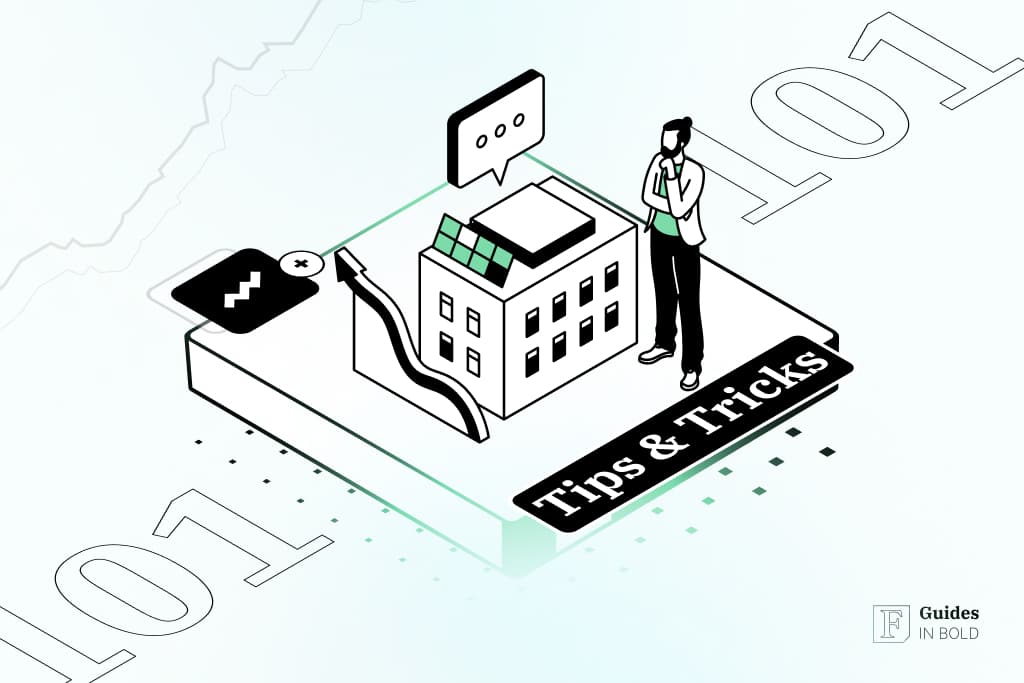Investing in public companies usually implies a level field for all investors. However, obtaining insider information gives an investor an advantage over every other participant. Leveraging insider information to inform one’s stock trading decisions is called insider trading. This guide will explain the fundamentals of insider trading, how it affects the market, and how you can use it for your benefit.
Receive Signals on SEC-verified Insider Stock Trades
This signal is triggered upon the reporting of the trade to the Securities and Exchange Commission (SEC).
What is insider trading?
You’ve just received information that the “blockbuster” cancer drug your company rallied behind is not getting approved by the FDA. In fact, the information will go public in a matter of days, and the company’s stock price will plunge. However, the shareholders aren’t aware of this yet. If you act quickly, you could sell your position and remain unaffected… Determined, you grab your phone and dial your family, urging them to offload their positions, too.
This (or something similar) actually happened in late 2001 when Martha Stewart, the founder and former CEO of Martha Stewart Living Omnimedia, and Samuel D. Waksal, the founder and CEO of ImClone, used insider information to instruct their family and close associates to sell their positions in the company. However, the attempts at illegal insider trading failed due to the timely intervention of the U.S. Securities and Exchange Commission (SEC).
Insider trading definition
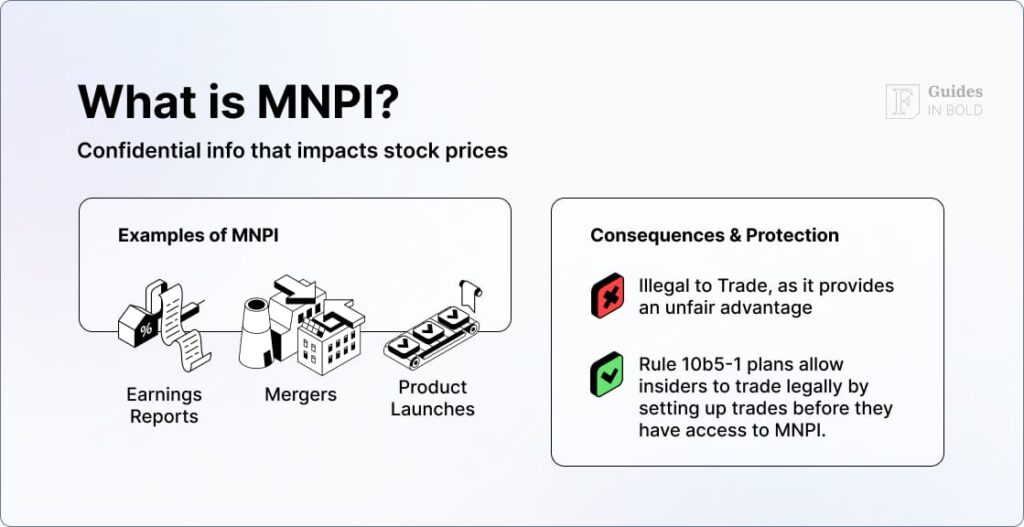
Material non-public information means any information that can substantially impact the decision to buy or sell the security that is not legally public domain and remains known to a limited circle of people, such as corporate executives or government officials. In other words, insider trading refers to trading company securities based on information other shareholders do not know yet.
In other words, insider trading refers to trading company securities based on information other shareholders do not know yet.
Recommended video: Insider Trading Explained in 2 Minutes
Who is an insider?
As these roles in a public company carry the legal and ethical duty toward the company and all public shareholders, people occupying them are obliged to put shareholders’ interests before their own. Insider information can have a profound impact and understanding the role of insider information in stock markets is vital.
Therefore, when insiders use material non-public information about the company when buying or selling company shares, they are violating their obligation. As such, this type of insider trading is illegal in most countries.
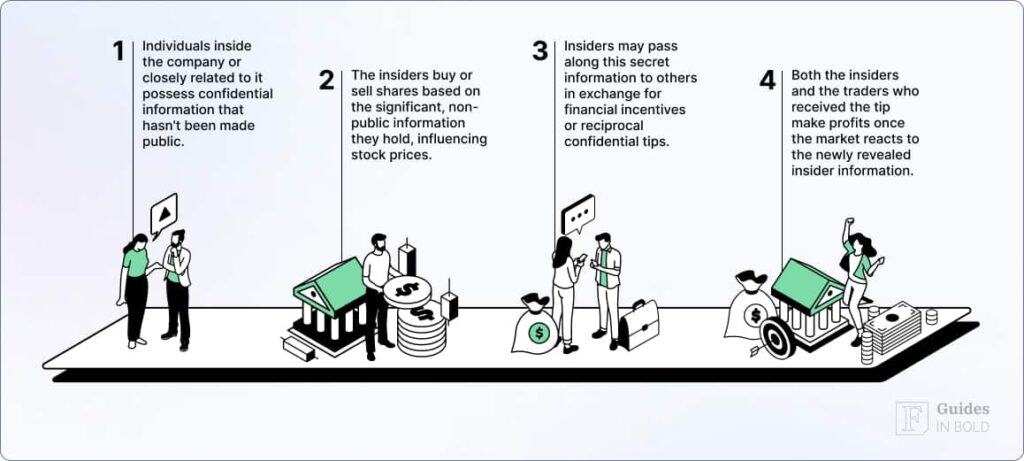
With this in mind, corporate insiders may pass the insider information to a friend, family member, or associate to evade direct responsibility. In some jurisdictions (including the U.S.), receiving such “tip” also makes you an insider. In other words, any individual who trades shares based on material non-public information breaks shareholder trust and is likely violating the law.
Legal vs. illegal insider trading
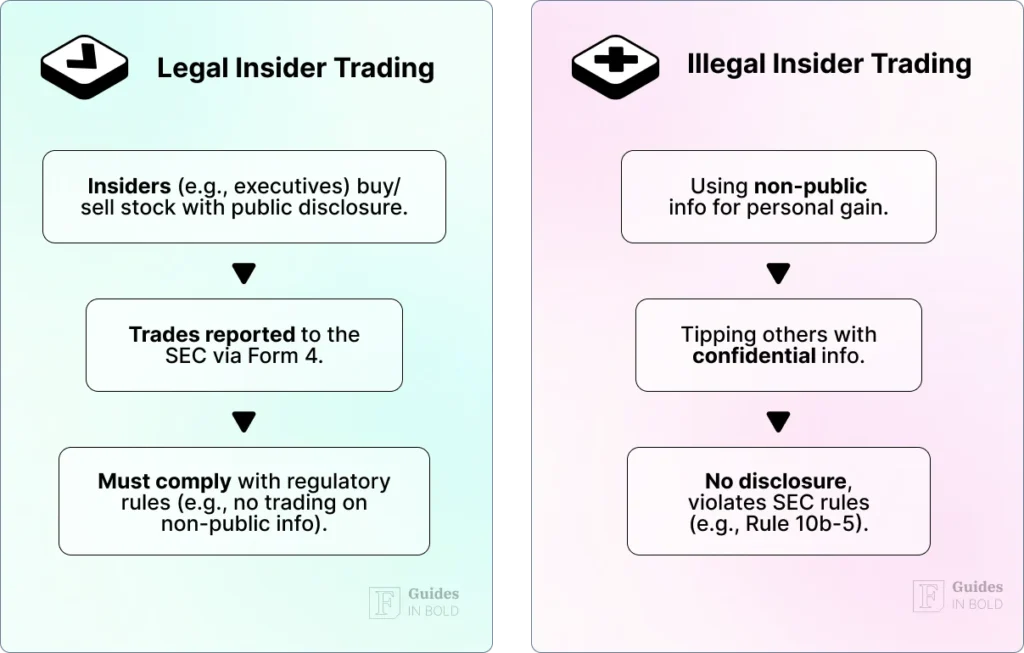
So, insiders trading company securities based on non-public information constitutes a breach of trust and, most often, also a violation of the law. However, most company executives own stocks or stock options in the company they run. How can they benefit from company securities?
Legal insider trades are insider trades that abide by the regulation of the financial authority. In the United States, the SEC Rule 10b5-1 allows insider trades based on a pre-existing contract or written and legally binding plan for trading after a period of time.
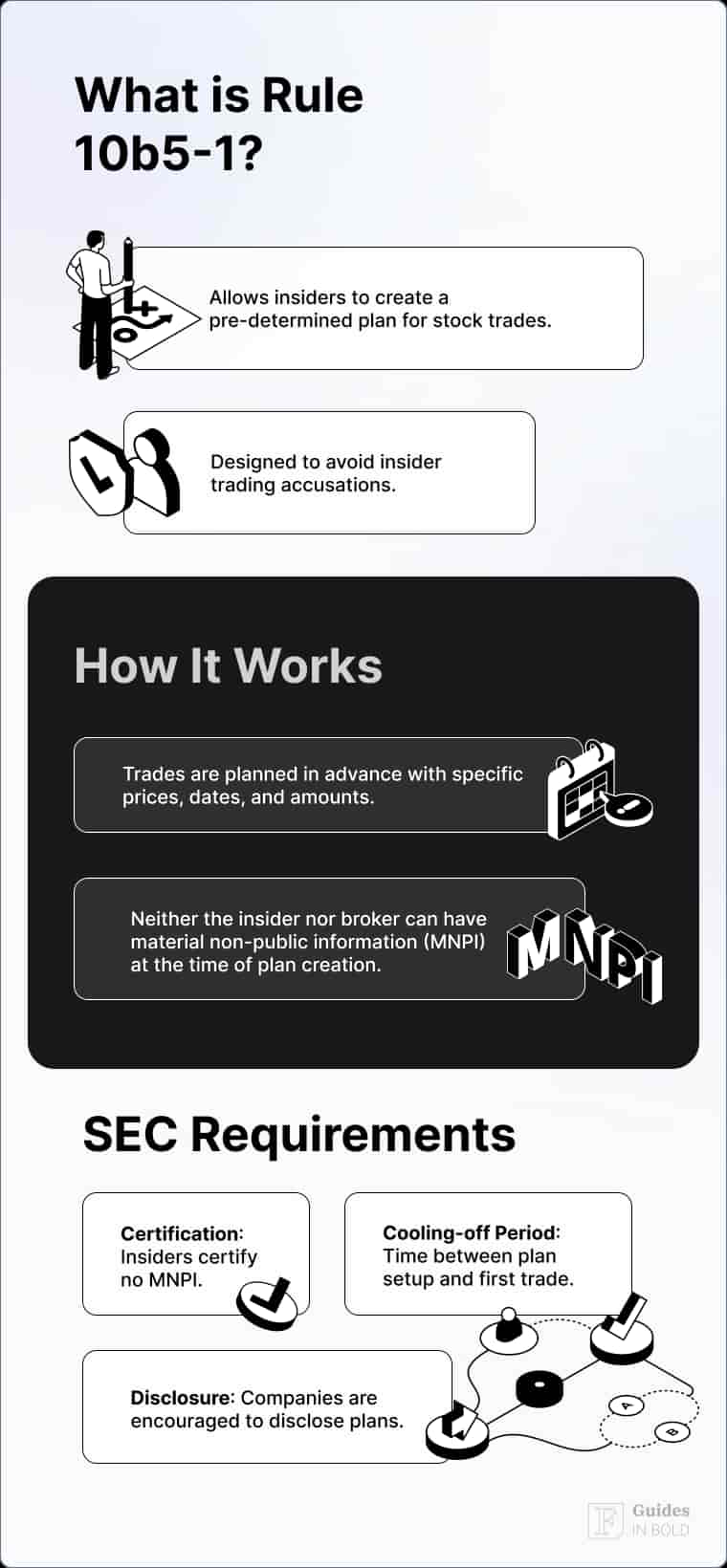
For example, a corporate officer intending to retire can make a written plan to sell a pre-set amount of the company’s shares every six months. This way, even if they come into possession of insider information that can affect their trading decision after they make the plan, such insider trading would be legal.
Insider trading is illegal when individuals rely on confidential information to trade securities. Most common illegal practices incorporate the following elements:
- Trading on MNPI: This is the most direct form of illegal insider trading. The story from the beginning, where the CEO sells stock based on the knowledge that the stock price will crash before that information is made public, is an excellent example of this;
- “Tipping”: The practice of sharing confidential information about a company with a person, referred to as “tippee,” who trades based on that knowledge. In this case, both parties are violating the law. Obtaining the information by nature of work (e.g., legal or financial advisors), or even by accident, prevents the person from trading based on it;
- Omissions and false disclosures: Legal insider trades must be adequately disclosed to the public. Failing to report a trade, withholding parts of information, or in any other way lying or deceiving the public constitutes a legal offense;
- Selective disclosure: Sharing insider information with a limited group of investors for personal gain (e.g., “trading” insider information) is illegal. Any practice that does not fully and indiscriminately inform the investing public is liable for prosecution;
- Front-running: If a broker or analyst uses foreknowledge to commit a transaction or sell information before filing client orders, they violate the law. An example would be a broker who receives a large order from a client to buy company stock but first buys shares for themselves, knowing that the large order will cause the stock price to rise. Once they file the client’s order and the price increases, they sell for a quick and sure profit.
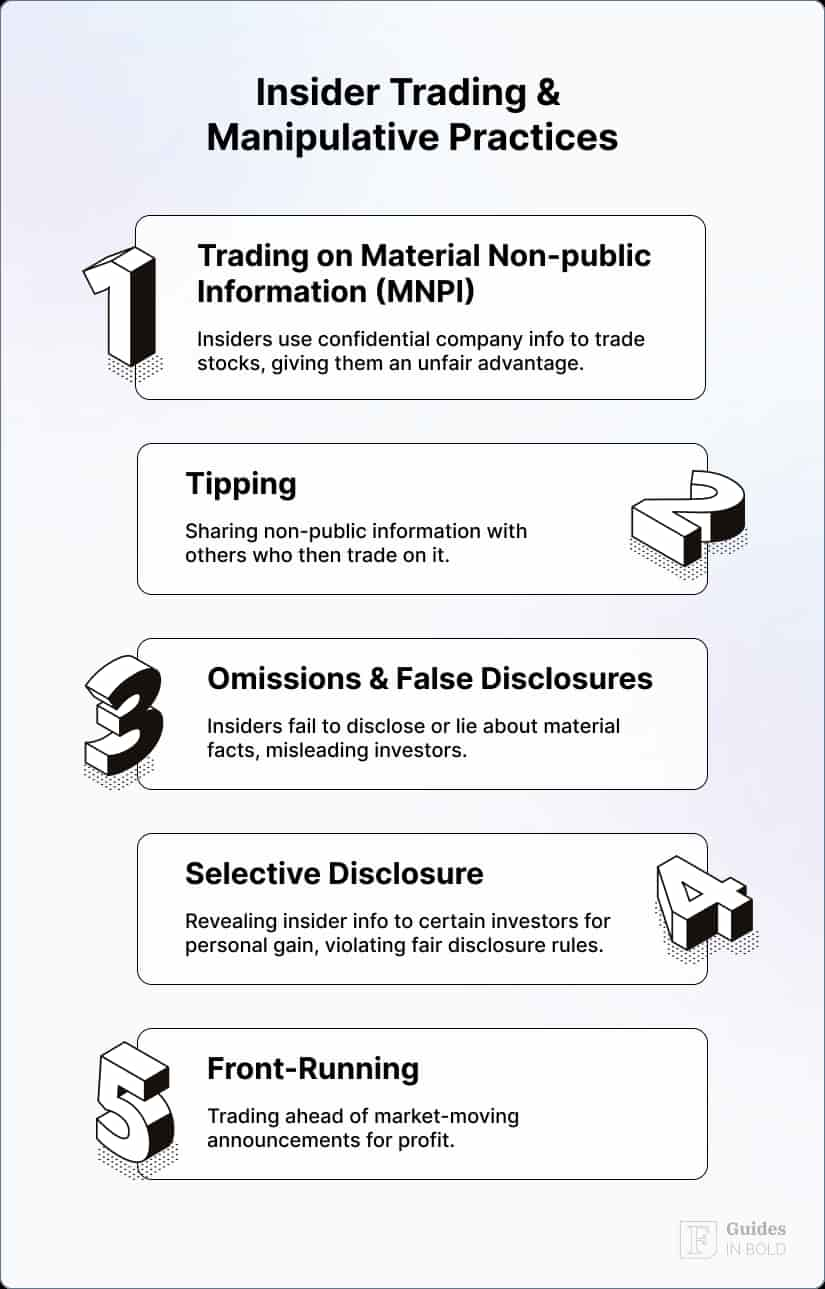
SEC prosecution cases
The U.S. Securities and Exchange Commission (SEC) is a U.S. federal agency designed to enforce the law and prosecute all forms of market manipulation, including insider trading. According to the SEC, typical examples of prosecuted cases include:
- Corporate executives and employees who traded company securities after obtaining significant and confidential information;
- Friends, family members, close associates, and other “tippees” of corporate insiders who traded company securities after learning such information;
- Finance and law employees who traded securities based on company information learned while providing their services;
- Elected officials, government employees, and their advisors who made trades based on private information obtained via their position;
- Anyone else who discovered and took advantage of MNPI from their employers, associates, family, friends, or others.
Penalties for insider trading
The U.S. Department of Justice (DOJ) and the SEC are the principal authorities dedicated to enforcing insider trading laws. Penalties can be civil and criminal, depending on the scale and severity of the violation.
Civil penalties include:
- Fines: The SEC can order the perpetrator to pay civil fines of either up to 300% of the profit gained or the loss avoided as a result of the illegal insider trading, known as “treble damages.”
- Disgorgement: Those responsible for the illegal transaction are also required to disgorge any gains, meaning that they have to return whatever profits they made or losses they avoided as a result of the unlawful insider trades.
- Injunctions: The SEC can issue temporary or permanent prohibitions to individuals from serving as corporate officers, directors of public companies, or even from trading stocks altogether.
Criminal Penalties include:
- Imprisonment: Depending on the severity of their crime, convicted individuals are liable for imprisonment of up to 20 years for each violation. The sentence depends on the amount of profit and the perpetrator’s previous history with similar offenses;
- Criminal fines: Besides prison time, individuals can also be fined up to $5 million. Corporations are liable to criminal fines of up to $25 million instead.
Infamous insider trading examples
Despite the SEC rules and efforts, insider trading cases are commonly tough to discover and prosecute due to a lack of concrete evidence, especially if perpetrators are not caught with a “smoking gun.”
That said, the financial authorities know which signs to look for in insider trading and other manipulative methods.
Many historical cases received enormous media attention, especially when the perpetrators were high-profile people. Here are some notorious insider trading cases that made the headlines:
Martha Stewart’s dumping of ImClone stock
Remember the story from the beginning? In 2001, the FDA declined to approve ImClone’s cancer drug Erbitux. The company leveraged the new drug to attract investment, and the news was almost guaranteed to cause the company’s stock to plummet. However, before the news went public and the stock hit the fall, the CEO of ImClone, Samuel Waksal, told some of his corporate executives, family, and friends to sell their shares.
Martha Stewart, a businesswoman and TV personality, sold all 3,928 of her shares in ImClone and avoided a loss of $45,673 based on a tip from her broker, who noticed that Waksal was also selling all his shares. Stewart drew heavy media attention due to the incident. Notably, she held onto her position on the New York Stock Exchange board of directors for four months after news of the insider trade broke out.
Stewart was ultimately sentenced to five months of prison and fined nearly $230,000.
Albert Wiggin and the “anti-Wiggin” law
On Black Thursday, which preceded the Great Depression, Albert Wiggin commissioned substantial funds from Chase National Bank to purchase sliding shares and thus prop up and stabilize the crashing market, for which he was called “a hero.”
However, unknown to the public, he was short-selling his personal shares in Chase National Bank while committing the bank’s funds to purchase stocks. He shorted more than 42,000 shares and earned more than $4 million using a Canadian shell company. Although the practice was not illegal at the time, the provision that banned company directors from shorting their position or otherwise benefiting from their company’s failure was named the “Wiggin Provision.”
Ivan Boesky and his lucrative tips
Boesky was a stock trader and arbitrageur who became infamous for a major insider trading scandal in the 1980s. In fact, he made hundreds of millions of dollars by speculating on corporate takeovers. However, his bets were made using insider information, primarily tender offers, mergers, and other likely business combinations, tipped from corporate insiders, including Michael Milken and Robert Wilkis.
In 1986, he made a plea agreement and cooperated with the authorities to inform on his partners. Time magazine ran a cover story about his misdeeds, calling him “Ivan the Terrible.” He was sentenced to three and a half years in prison and fined a record $100 million. Furthermore, he was permanently banned from trading securities.
Insider trading: Congress
The laws that prohibit insider trading also apply to U.S. Congress members. However, since they usually have no ties or confidential relationship with a company, they commonly fail to meet the definition of an insider. However, their unique position gives them access to material information before the general public.
Due to this “gray zone,” many representatives and senators own and trade individual stocks despite the practice’s controversy. A 2004 study showed that stock trades made by senators outperformed the market by 12.3% per year. Also, a report by Business Insider revealed that a group of senators, including Dick Durbin, shorted or sold some of their assets a day after they were informed about the consequences of the Great Recession.
In 2012, the Stop Trading on Congressional Knowledge (STOCK) Act was enacted to monitor assets and hold elected officials and federal employees liable for stock trades they made using insider information.
Receive Signals on US Congress Members' Stock Trades
Stay up-to-date on the trading activity of US Congress members. The signal triggers based on updates from the House disclosure reports, notifying you of their latest stock transactions.
Should insider trading be legal?
Some economists, academics, and legal experts have advocated legalizing all insider trading because insider trading introduces new information to the market more quickly.
For example, economist and Nobel laureate Milton Friedman said:
“You want more insider trading, not less. You want to give the people most likely to have knowledge about deficiencies of the company an incentive to make the public aware of that.”
Friedman believed that insider traders should not be required to publicly disclose their trade as the pressure from the trade itself represents information for the market.
Additionally, its proponents claim that insider trading is the closest thing to a “victimless” crime in modern finance. Furthermore, they compare stock market insider trading to other markets, such as real estate, where asymmetric information is not illegal. For example, a geologist who discovers oil on real estate does not need to inform the farmer from whom he buys the land.
What can insider trading tell?
Since insider trading has to be publicly disclosed to be legal, all investors can access the forms and derive conclusions from such trades. But what can these trades tell you, and how can these forms help analyze insider trades and predict market movements?
Insider buying
“Insiders might sell their shares for any number of reasons, but they buy them for only one: they think the price will rise.” — Peter Lynch, a Fidelity Investments manager, in One Up on Wall Street
When insiders use their own money to buy more company shares, they likely have confidence in the company’s potential and future investments—especially if the amount of stock is significant.
Insider selling
Unlike buying, insiders sell their positions for various reasons. It might signify a bearish sentiment toward their company’s stock price, but they might just as well need the cash for something else, like buying a house.
For a more informed decision, compare the form with other corporate officers from the same company. Are they all selling, or is that an individual trade? Is the amount significant or minor? A single, insubstantial sale might not mean anything, but a collective decision to drop their positions might mean a storm is on the horizon for the company.
Elon Musk and insider selling

Speaking of insider selling, an excellent example is the case of Elon Musk, the CEO of Tesla (NASDAQ: TSLA). In fact, between December 12 and 14, 2022, Musk sold nearly $3.6 billion worth of his shares in the company. Three weeks later, the company announced it fell short of its delivery targets by almost 22,000 vehicles.
Tesla was one of the worst-performing stocks that year. Needless to say, the case seems highly suspicious, and many accused Musk of insider trading, including a shareholder who even sued the eccentric billionaire in May 2024 for breaching his fiduciary duties to the company and its shareholders.
Stock price signaling
On the other hand, corporate insiders may have different intentions than profit when they trade stock:
- Insiders could buy stock to reinforce confidence and trust in the company and stock price during troubling times. After all, they are aware of the public attention;
- Bearish market sentiment (such as due to a weak earnings report) could motivate insiders to buy to negate the downward trend or counter short-selling;
- Insider buying or selling is frequently used as an alternative to quarterly reports, earnings forecasts, or conference calls.
The effects of insider trading on stock price and trading volume
A study published in 2021 implies that insider trading by corporate insiders and substantial shareholders affects stock price and volume but not always returns. The study also shows that once the investing public learns about insider trades, they purchase securities, which causes stock trade volume and price to rise.
Furthermore, trades made by high-ranking corporate insiders, such as directors, executives, and substantial shareholders, tend to yield abnormal returns, unlike those made by lower-ranked employees.
Where to find insider trading information?
As you can see, insider trading is worth monitoring and provides information that can inform your stock trading decisions. However, the question remains: how do you obtain insider trading information?
The SEC requires all companies listed on the U.S. stock markets to file regular reports and disclose insider trading transactions. Some of the most relevant reports are included in the SEC’s EDGAR database. Let’s take a look!
Forms 3, 4, and 5
These forms report insider ownership when shareholders obtain more than 10% of voting power across different stock classes.
- Form 3: This form is filed the first time the shareholder acquires over 10% of voting power and helps the SEC track initial owners;
- Form 4: Insiders file this report whenever they buy or sell company stock. It has to be disclosed within two business days of the transaction. The report includes the position of the shareholder within the company;
- Form 5: Filed annually, this report provides the SEC with regular updates on the company ownership structure.
Form DEF 14A
This form, also known as the Definitive Proxy Statement, represents a list of directors, corporate officers, and significant beneficial owners (>5%) with the number of shares each owns. It must be filed before the annual shareholders’ meeting and includes other useful information, such as board member nominations, salaries, and other compensations.
Schedules 13D and 13G
These forms, otherwise known as “beneficial ownership reports,” are filed whenever an individual or institution acquires more than 5% of company equities with voting power. The only difference between the two forms is that 13G is shorter than 13D, and depending on the circumstances of the purchase, Schedule 13G could be filed instead of 13D.
The reports must be filed within ten days of the purchase and include information on the issued securities and exchanges where the assets were traded.
Online tracking services
Although the EDGAR database is comprehensive, it is frequently too exhaustive for a single person to effectively track. That said, various online insider trading trackers, such as Finbold Signals, provide a filtered selection of the most important or relevant companies and their insider trading.
Receive Signals on SEC-verified Insider Stock Trades
This signal is triggered upon the reporting of the trade to the Securities and Exchange Commission (SEC).
How does the SEC track insider trading?
Although discovering and prosecuting illegal insider trading is notoriously tough, the SEC has the following methods at its disposal:
- Market monitoring: The SEC can use refined data analytics aided by artificial intelligence tools to observe trading patterns and discover anomalies that betray insider trading. The primary observation periods are those in proximity to earnings reports, mergers, and various other critical company announcements;
- Tips and complaints: Some of the vital information that leads to the discovery of illegal insider trading comes from tips by offended investors, other insider traders, and company whistleblowers. The SEC actively encourages individuals to report market manipulations with incentives that include monetary compensation;
- Joint efforts: The SEC cooperates with other organizations, including federal, state, private, and self-regulatory groups and organizations (such as the Financial Industry Regulatory Authority or FINRA) and their international equivalents to share knowledge and coordinate efforts.
- Options trading analysis: Suspicious options trading can be a vital signal of insider trading. For example, the SEC tightly monitors out-of-the-money options activity, particularly those anticipating substantial corporate and market events.
- Social media and alternative data: Ultimately, The SEC even observes social media and other data sources for potential leaks of MNPI.
Which company insider should I track?
While all insider trades are relevant, some can tell you more than others. Pay more attention to the following:
- Multiple insider trades: If several corporate insiders trade over a short period, this might indicate a trend within the board. If a group of insiders buys, this may indicate significant confidence in the stock. However, if several of them sell simultaneously, it might be time to abandon your position;
- Large transactions: Large transactions tell you more than small transactions. Consider the volume of the trade: sometimes a single large trade means more than several smaller ones;
- Trading history: Insiders who regularly file their SEC forms should be observed more closely than those with little past activity;
- Company hierarchy: Finally, the decision made by top executives carries more weight than those made by their subordinates. Look for transactions made by corporate chiefs.
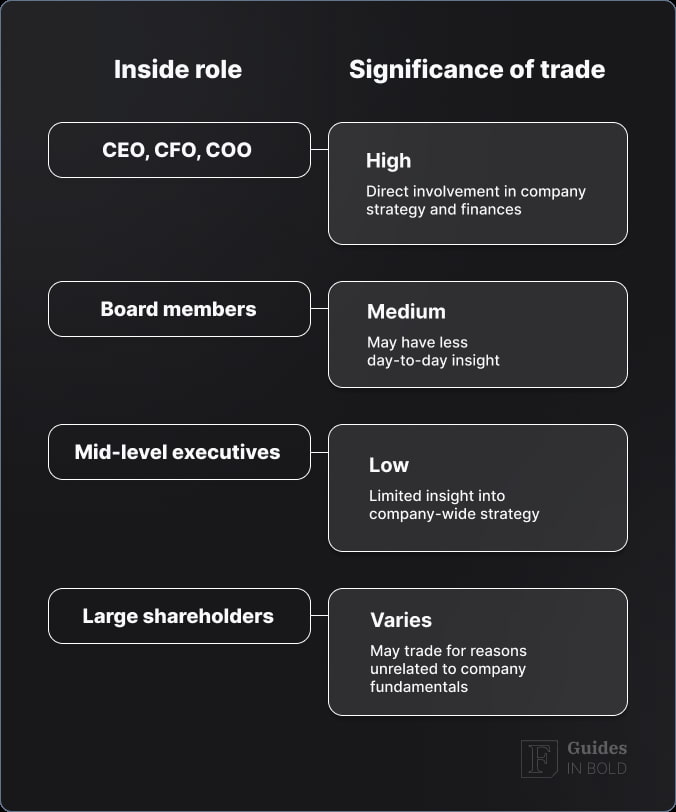
Tips and tricks for insider trading
A comprehensive list of clearly laid out tips and tricks to follow when considering insider trading is tough to make and implies a great deal of simplification. That said, if you want an in-depth look at how to leverage insider trade info for informed investment decisions, check out our dedicated guide here.
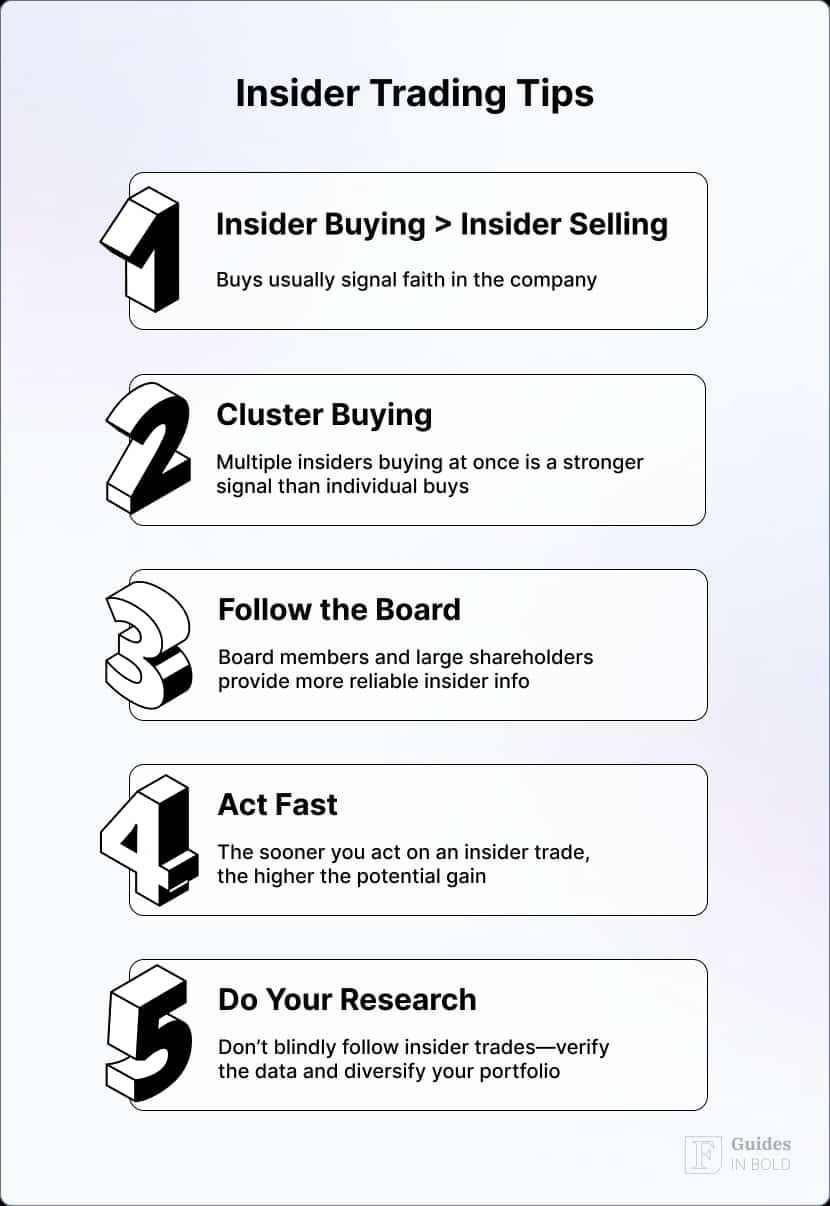
Here’s an overview:
- Insider buying tells more than insider selling. When corporate executives buy their company’s stocks from their own pocket, it nearly universally indicates confidence in the future. While insider selling can have numerous causes, insider buying is a strong indicator to follow in their footsteps;
- Cluster buying. What’s more conclusive than insider buying? Several corporate insiders buying at the same time. This also removes the chance of individual ad hoc decisions that might come from “gut feeling” or personal optimism. The more insiders buy at the same time, the greater the chance that you’ll earn if you buy as well;
- Go with the board rather than the managers. Directors are higher in the company ownership structure: insider information is more likely to be accurate if it comes from the top. You should also consider the moves made by shareholders with more than 10% of voting power, as they stand to win or lose more from the company’s future than the regular investor or company manager;
“Particular note should be taken of buying by the chief executive and finance director. They ought to know exactly what is happening within the business and it is always encouraging to see them put their money where their mouth is.” — Jim Slater, a British accountant and investor, from The Zulu Principle.
- Act quickly. The sooner you act on an insider trade, the higher the potential benefits. Remember, there are many investors, and the word spreads quickly online. If you are confident in the integrity of your signal, act as soon as possible;
- Do your own research. While it may be tempting to just copy the big shark trades, you should always do your own research. Executives, especially company founders and CEOs, have their personal lives tied to the fate of their company. You, on the other hand, do not. If your gut feeling and (more importantly) research says that the insider is wrong, do not copy them. Rein in emotions, manage risk, and diversify your portfolio!
Pros and cons of using insider trade information
Finbold has compiled a detailed set of pros and cons of relying on insider trade information, but here’s a brief summary of its contents:

Pros
- Insight into the company’s future: Insiders tend to know more than the investing public, so their trades could indicate the company’s trajectory;
- Alignment with smart money: Insiders’ confidence comes from their knowledge about the company;
- Publicly available data: Owing to the SEC, insider trading reports are free and publicly available;
- Legal safeguards: Unlike trading based on insider information, trading based on other insider trades is legal.

Cons
- Not always a clear signal: Insiders conduct trades for reasons that are not always obvious;
- Information delays: Insider trades are disclosed within two days and never revealed real-time;
- Complex market factors: The stock market is complex, and insider trading is one signal among many;
- Legal and ethical risks: Although copying insider trades is legal, caution must be exercised to evade MNPI.
Common mistakes when using insider trade information
Like with anything related to investing, mistakes can happen, especially when you blindly apply a set of guidelines. Finbold has put together a list of mistakes to avoid when relying on insider data, but the gist of it is:
- Assuming all insider purchases are positive and insider sales are negative. Insider selling stems from various reasons, and even insider buying could be a part of a signaling tactic. Look for patterns over time rather than single instances;
- Ignoring the insider’s role within the company. In the corporate hierarchy, not everyone has the same level of access to information. A director always knows more than a clerk;
- Overlooking the size and frequency of trades. Ten consecutive trades tell you more than a single transaction. Similarly, a $10,000 purchase yields less information than one worth $500,000;
- Failing to consider external factors. External factors are important, such as circumstances like broader market conditions, covering tax liabilities, and pre-arranged trading plans. Not every insider trade is based on insider information;
- Neglecting the insider’s overall ownership levels. When Mark Zuckerberg sells 1.28 million shares for $428 million, that represents a fraction of his ownership over Meta (NASDAQ: META) and speaks little of his intentions. However, executives selling half or all of their shares can speak volumes. Always take into account ownership levels.
Receive Signals on SEC-verified Insider Stock Trades
This signal is triggered upon the reporting of the trade to the Securities and Exchange Commission (SEC).
Disclaimer: The content on this site should not be considered investment advice. Investing is speculative. When investing, your capital is at risk.
FAQs about insider trading
What is insider trading?
Insider trading is the practice of buying or selling securities of a public company while possessing material information about the company that is not known to the investing public.
Is insider trading legal?
Insider trading is generally illegal unless it follows the regulations issued by the financial authorities. In the United States, for example, legal insider trading has to be publicly reported and done according to a binding written plan.
Where can I find insider stock trade data?
All insider trading must be reported to the SEC for companies listed on the U.S. stock exchanges. As such, it is available on the EDGAR database. However, due to the sheer size and volume of trading reports, it might be more convenient to employ the services of an insider trading tracker such as Finbold Signals.
What is an example of insider trading?
An example of insider trading is when an executive in a company finds out about a merger and buys more shares before the information becomes public. In most countries, this type of insider trading is illegal, even if done through a proxy (e.g., a friend or an associate).
How do authorities discover illegal insider trading?
It is notoriously difficult to catch illegal insider trading. Unless there is a suspicious movement in the publicly disclosed financial forms, it will likely go under the radar. However, due to the efforts of the SEC, all insider trading has to be publicly reported and remains carefully monitored.
